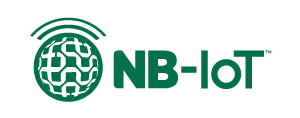Introduction to cellular IoT
Introduction to cellular IoT
LTE-M
Low power, mobility and low latency for your applications
LTE-M (also known as Cat-M1) is designed for low-power applications requiring medium throughput. It has a narrower bandwidth of 1.4 MHz compared to 20 MHz for regular LTE, giving a longer range, but less throughput. The throughput is 375 kbps uplink and 300 kbps downlink, providing approximately 100 kbps application throughput running IP. It is suitable for TCP/TLS end-to-end secure connections. Mobility is fully supported, using the same cell handover features as in regular LTE. It is currently possible to roam with LTE-M, meaning it is suitable for applications that will operate across multiple regions. The latency is in the millisecond range offering real-time communication for time-critical applications.
LTE-M is perfect for medium-throughput applications requiring low power, low latency, and/or mobility, like asset tracking, wearables, medical, POS and home security applications.

NB-IoT
Low power, range and adaptability for your applications
NB-IoT (also known as Cat-NB1) is a narrowband technology standard that does not use a traditional LTE physical layer but is designed to operate in or around LTE bands and coexist with other LTE devices. It has a bandwidth of 200 kHz, giving it a longer range and lower throughput compared to LTE-M and regular LTE. The throughput is 60 kbps uplink and 30 kbps downlink. It is suitable for static, low-power applications requiring low throughput. With the introduction of Cat-NB2 in 3GPP release 14, you can achieve a throughput of 169 kbps uplink and 127 kbps downlink if the network supports it.
NB-IoT is perfect for static, low throughput applications requiring low power and long-range, like smart metering, smart agriculture and smart city applications. It also provides better penetration in, for example, cellars and parking garages compared to LTE-M.

LTE-M and NB-IoT key features comparison
| LTE-M | NB-IoT |
|||
|---|---|---|---|---|
| Also known as | “eMTC”,”LTE Cat-M1” | “LTE Cat-NB1” (3GPP rel 13) - "LTE Cat-NB2" (3GPP rel 14) | ||
| Max Throughput (DL/UL) |
300/375 kbps |
30/60 kbps (NB1) - 127/169 kbps (NB2) |
||
| Range |
Up to 4x | Up to 7x | ||
| Mobility/cell re-selection | Yes | Limited | ||
| Frequency deployment | LTE In-band | LTE In-band, guard band and GSM re-purposing | ||
| Deployment density | Up to 50,000 per cell | Up to 50,000 per cell | ||
| Module size | Suitable for wearables | Suitable for wearables | ||
| Power consumption | Up to 10 years of battery lifetime | Up to 10 years of battery lifetime | ||
Energy efficiency
Revolutionizing energy efficiency
Energy efficiency is a cornerstone of cellular IoT technology. Both LTE-M and NB-IoT are designed to make years of operation from a battery-driven power source a reality. This has been achieved by using a range of techniques. Data throughput is lower than standard LTE, and this brings the energy consumption down due to slightly simpler modulation schemes and less complex radios. However, as with all low power communication technology, the real key is managing sleep, wake-up and communication events effectively and efficiently.
Two energy efficiency innovations make a significant contribution to LTE-M and NB-IoT power-saving capabilities, eDRX (Extended Discontinuous Reception) and PSM (Power Saving Mode). Both eDRX and PSM work in harmony to make battery operation for many months and years possible.
LTE uses a system of paging cycles which are typically 1.28 seconds in duration. A paging cycle is the window of time a device can be contacted by the network for an exchange of data. The resting period between the paging windows is known as hyper-frames. The benefit of eDRX is that it allows ‘N’ number (40+) of hyper-frames to occur at a period of 10.24 seconds each before a device wakes up again for activity in its next paging window. In this way, devices can sleep and talk in a highly efficient and synchronized manner.
PSM mode simply enables the device to enter a deep sleep mode for whatever time is necessary, this could be perhaps an hour, a day, or weeks. For applications that have no real-time requirements and only communicate very periodically, for example, an irrigation system in agriculture, this brings very high levels of energy conservation and can mean products can run on a few AA-sized lithium batteries for up to 10 years.
The nRF91 Series are optimized to take full advantage of all the power-saving efficiencies offered by LTE-M and NB-IoT including eDRX and PSM.

In addition to these features, 3GPP release 14 introduced support for Release Assistant Indication for Access Stratum (AS-RAI). This is a power saving feature that allows a device to enter idle mode immediately after sending data, effectively reducing the power consumption of data transmissions by more than half.
Quality of service
Empowering reliable connectivity
When it comes to the realm of LPWAN (Low-Power Wide Area Network), cellular networks stand head and shoulders above the rest, offering an unparalleled set of performance characteristics. The secret behind their exceptional reliability lies in operating within licensed bands—a factor that should not be underestimated. Acquiring these licensed bands often involves significant investments, often reaching billions of dollars, and for good reason. Ownership of these bands grants the ability to dictate and ensure the performance and reliability of communication within them, while minimizing energy wastage due to interference between devices.
One of the defining features of cellular networks is their unwavering commitment to delivering a very high Quality of Service (QoS). With a known and manageable number of connections, cellular networks are designed to accommodate and prioritize them accordingly. In stark contrast, unlicensed bands offer no such guarantees, allowing anyone to operate within them. When it comes to guaranteeing consistent performance and unwavering reliability, licensed cellular networks emerge as the unequivocal winners in the LPWAN landscape.
By leveraging the power of licensed cellular networks, you can rest assured knowing that your connectivity requirements are met with utmost precision. The assurance of QoS ensures that your critical applications, sensitive data transfers, and mission-critical operations are flawlessly executed. With cellular networks, you unlock a level of reliability and performance that simply cannot be matched by their unlicensed counterparts.
Deployment density and coverage
Unleashing the power of deployment density and seamless coverage
With existing 4G cellular networks already in place, cities across the globe boast an extensive infrastructure of cell towers, ensuring dense coverage. Furthermore, most countries have achieved a high degree of country-wide coverage. This remarkable foundation positions cellular technology as the ideal choice for deployment on an unprecedented scale, with minimal infrastructure requirements.
The advent of LTE-M and NB-IoT brings an added advantage: their intrinsic design prioritizes spectral efficiency. Leveraging this efficiency, coupled with the inherently low activity nature of typical use cases, these technologies empower the connection of tens of thousands of devices to a single base station. It's important to note that cell towers typically host multiple base stations, magnifying the potential for massive-scale deployment.
This synergy of factors unlocks unparalleled deployment density, allowing for a seamless proliferation of cellular IoT devices across various industries and domains. The cellular infrastructure is primed and ready to handle the connectivity needs of countless devices, ensuring that your IoT solutions can be seamlessly integrated and managed at an unprecedented scale.
Best-in-class security
Setting the standard for uncompromising security
When it comes to security measures in the LPWAN sector, LTE networks reign supreme, offering unrivaled protection as the standard. At the device level, a pivotal element is the SIM card or UICC (Universal Integrated Circuit Card). Embedded within the SIMs hardware, this secure element boasts a definitive identifier, ensuring authentication to the cellular service subscription and encrypting data over-the-air. Such robust measures safeguard the integrity of your communication.
In the realm of LTE, communication takes place using the trusted TCP/IP and UDP protocols, the very languages of the internet. As a result, it inherits the highest degree of security measures currently in use. At the forefront of securing data transactions is Transport Layer Security (TLS) and Datagram Transport Layer Security (DTLS), state-of-the-art mechanisms that safeguards your information with uncompromising encryption and authentication protocols.
Elevating the bar even further, the nRF91 Series incorporates additional cutting-edge security measures to fortify device integrity. With Arm TrustZone and Arm CryptoCell, the device ensures secure and trusted execution, as well as advanced key generation and storage capabilities. These layers of security work in unison to safeguard your device and the data it transmits.
Just as updates are critical for maintaining the security of any connected computer, your connected device must also be capable of receiving firmware updates over-the-air (FOTA). This functionality ensures that any security vulnerabilities discovered after deployment, whether they pertain to standards or implementation, can be promptly addressed. It empowers you to optimize your device's performance over time and seamlessly deploy new features, all while ensuring the highest level of security. This can be achieved by using nRF Cloud FOTA services.
nRF Cloud Security Services provides additional security measures for the customer to use with Secure Identity and Secure Provisioning. These two services enable the user to authenticate the Nordic silicon in the supply chain or any other stage of the production journey, making sure to protect the customers valuable Intellectual Property and possible counterfeiting. Secure Provisioning streamlines the delivery process by securely provisioning customer specific configurations over the air to enable flexible deployment and ease of global scalability.
Nordic offers a range of security features and has partnered with leading security providers to offer a complete end-to-end security solution for our customers.